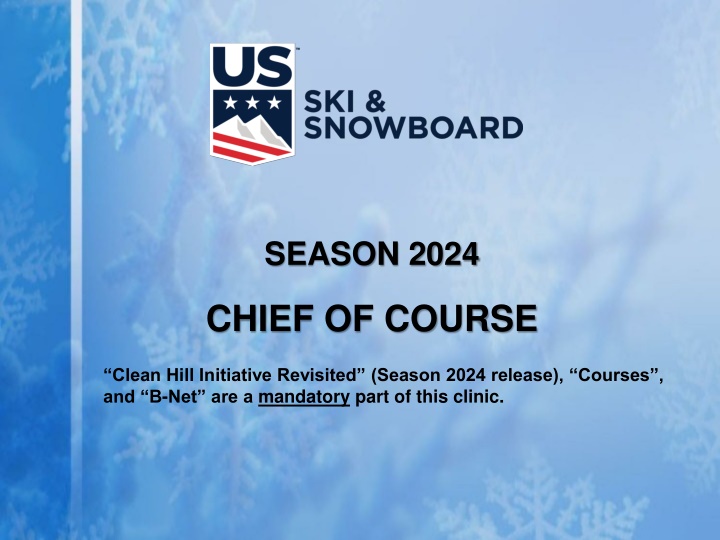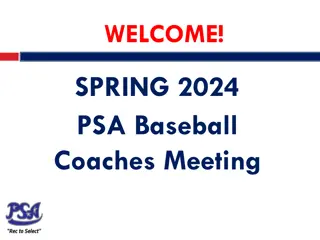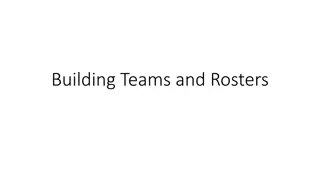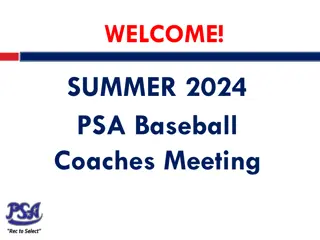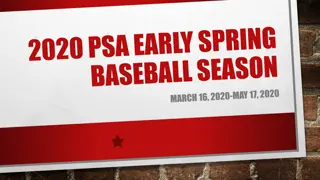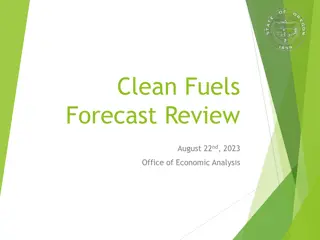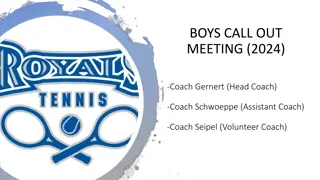Season 2024 Chief of Course Clean Hill Initiative Revisited
Comprehensive information on alpine skiing event operations and rules, emphasizing the importance of adherence to set procedures and regulations. Includes resources for officials, coaches, and competitors, highlighting the responsibility of all involved parties. Guidelines on application of rules for both FIS and non-FIS events, and a focus on minor athlete abuse prevention policies.
Download Presentation

Please find below an Image/Link to download the presentation.
The content on the website is provided AS IS for your information and personal use only. It may not be sold, licensed, or shared on other websites without obtaining consent from the author.If you encounter any issues during the download, it is possible that the publisher has removed the file from their server.
You are allowed to download the files provided on this website for personal or commercial use, subject to the condition that they are used lawfully. All files are the property of their respective owners.
The content on the website is provided AS IS for your information and personal use only. It may not be sold, licensed, or shared on other websites without obtaining consent from the author.
E N D
Presentation Transcript
SEASON 2024 CHIEF OF COURSE Clean Hill Initiative Revisited (Season 2024 release), Courses , and B-Net are a mandatory part of this clinic.
IMPORTANT NOTICE Procedures which impact your event operations and programs must be relayed to all event officials, Team Captains, and competitors. The procedures must without question be respected and observed.
ALPINE OFFICIALS RESOURCE MATERIALS Alpine Officials resource materials are prepared to be accurate and in compliance with current rules and procedures while maintaining a nationwide outlook. The content of the material is reviewed by senior Alpine Officials prior to being submitted for acceptance by appropriate U.S. Ski & Snowboard authorities. If an item included in the resource materials appears to be in conflict with current rules and procedures, please contact U.S. Ski & Snowboard Competition Services for clarification and/or interpretation.
OFFICIALS RESPONSIBILITY It is the responsibility of every official, coach and competitor to know, understand, and abide by the rules for the sport. These rules include, but are not limited to, current editions and Precisions of: - U.S. Ski & Snowboard ACR - FIS ICR - Supplemental rules, such as Equipment Specifications, Rules of the FIS Points, Rules for the Alpine Continental Cups, etc. Coaches, Program Directors, and other club officers are encouraged to provide the time and opportunity to instruct their athletes on the rules for the sport.
APPLICATION OF RULES For all events scheduled as non-FIS events, applicable U.S. Ski & Snowboard rules must be considered and applied (ACR) For all events scheduled as FIS events, applicable rules of the FIS must be considered and applied (ICR) In cases that are not addressed by the ACR or by the ICR, or in cases where the rules must be interpreted, the authority for making such decisions will rest with the Competition Jury all decisions must be documented!
MINOR ATHLETE ABUSE PREVENTION POLICY (MAAPP) SAFESPORT CODE The following slides referring to MAAPP and SafeSport are: Only a brief summary of information found in many documents Documents will be updated as required Please refer to links posted on the U.S. Ski & Snowboard website for access to complete and current information. usskiandsnowboard.org/safesport-athlete-safety/safesport-resources
MINOR ATHLETE ABUSE PREVENTION POLICY (MAAPP) MAAPP applies to In-Program Contact within the Olympic & Paralympic movement. Its implementation is required for the U.S. Olympic & Paralympic Committee IUSOPC), National Governing Bodies (NGB), Member Clubs (also known as Local Affiliated Organizations or LAO), and Paralympic Sport Organizations (PSO) MAAPP applies to all U.S. Ski & Snowboard employees, contractors, athletes, officials, and members It also applies to participating non-members, e.g., foreign officials, timing companies, volunteers, and any adult participants. MAAPP has three primary components: - Education & Training - Required Prevention Policies - Recommended Prevention Policies MAAPP should be implemented alongside the SafeSport Code.
SAFESPORT CODE U.S. Federal Law requires that adults who have frequent contact with, or who are in positions of authority over athletes, must receive consistent education on prevention and reporting of all allegations of sexual misconduct, bullying, hazing, and abuse of all forms This impacts all U.S. Ski & Snowboard member clubs, coaches, officials, and Club Volunteer members All members turning 18 years of age and older during the season are required to complete SafeSport training through the U.S. Center for SafeSport (substitutions are not permitted) U.S. Ski & Snowboard membership status for members who fail to complete required SafeSport Training will be noted as PENDING . They must not be issued any venue access that would allow competition arena access until their membership is complete.
ADMINISTRATION PER MAAPP & SAFESPORT: LOCAL ORGANIZING COMMITTEE (LOC) The Local Organizing Committee (LOC), as well as other individuals and entities as set out in the MAAPP and the SafeSport Code, are responsible for monitoring and enforcing all requirements. These requirements include, but are not limited to: Events: Any U.S. Ski & Snowboard member club hosting a U.S. Ski & Snowboard sanctioned event must follow the Competition Administration Summary available at usskiandsnowboard.org/safesport-athlete-safety/safesport-resources to ensure compliance with required athlete safety at at event. There are additional athlete safety event resources available on this webpage. Memberships: Using the U.S. Ski & Snowboard website, the Race Administrator must verify that all Jury members, Jury Advisors (Start and Finish Referees), Chief of Course, Course Setters, Coaches, Competitors, Forerunners, Chief of Timing & Calculations, Race Administrator, and medical staff have current and applicable U.S. Ski & Snowboard memberships. Individuals whose memberships are pending , or whose names appear either on the Centralized Disciplinary Database or the Pending Membership List must not be issued any venue access that would allow competition arena access.
ADMINISTRATION PER MAAPP & SAFESPORT: LOCAL ORGANIZING COMMITTEE (LOC) Alpine Official Certification Status: Using the U.S. Ski & Snowboard website, the Race Administrator must verify that all Jury members, Jury Advisors, Chief of Course, Course Setters, Chief of Timing & Calculations, and Race Administrator have appropriate certification as required by their position Alpine Official Continuing Education (Update) Status: Using the U.S. Ski & Snowboard website, the Race Administrator must verify that the Chief of Race, Referee, Assistant Referee (if required), Chief of Course, Course Setters, and Chief of Timing & Calculations have attended a biennial Continuing Education Clinic For Season 2024, the allowed minimum is Season 2023 attendance Unless excused, Technical Delegates and Race Administrators are required to attend a certification specific Workshop every season
ADDITIONAL REQUIREMENTS Centralized Disciplinary Database: List of individuals subject to temporary or permanent restrictions pending investigation of violation of SafeSport Code. Presence not allowed. Site allows filtering to sport. However, an individual may not be listed under one sport but may be listed under another; searching by name is the best practice. If you have a name match and cannot verify if it is the individual attending the event, please reach out to Member Services.
ADDITIONAL REQUIREMENTS Volunteer Competition Worker Registration: Completion of a current Volunteer Competition Worker Registration is required for any workers/volunteers who are over the age of 18, are not U.S. Ski & Snowboard members, properly credentialed FIS officials, coaches and trainers, or regular employees of Organizer or of Ski Area/Landowner acting within the scope of their employment. Blocks of coaches tickets must not be made available. Practice does not allow the OC to make their best effort to comply with SafeSport requirements Due to circumstances, it may be necessary to allow one coach to pick up all of a team s coach credentials/lift tickets In this case, the coach must list all the names to whom the credentials/lift tickets will be issued. Race Administrator must verify membership status, non-presence on pending lists, and non-presence on Centralized Disciplinary Database for all recipients Coach must sign for receipt of credentials/lift tickets, thereby confirming recipients identity In order to ensure compliance, all of the above requirements, verifications must be continually monitored and completed for same-day participants, and they must be informed of the SafeSport Code and MAAPP. This can be accomplished by posting the QR Code at registration and asking the same-day participants to scan and read the disclosure.
VOLUNTEER COMPETITION WORKER REGISTRATION Form is in the MPF Must be 18 years of age
PLEASE NOTE: The responsibility for communication and enforcement of SafeSport and MAAPP policies is: The responsibility of the Local Organizing Committee as well as other individuals and entities as set out in the Competition Administration Summary, the MAAPP and the SafeSport Code. All information is available on the U.S. Ski & Snowboard website at usskiandsnowboard.org/safesport-athlete-safety/safesport-resources The Jury is only responsible for technical matters within the closed competition areas. [601.4] The closed competition areas are defined as the race arena which is accepted as being those areas which the Jury inspects and accepts as being suitable for competitors presence: - start arena - race course - finish arena
CHIEF OF COURSE: Qualifications & Responsibilities The Chief of Course must know, understand, and abide by the rules and should participate in Team Captains Meetings, Jury inspections, and Jury meetings. Chief of Course at all U.S. Ski & Snowboard-sanctioned events must hold a current U.S. Ski & Snowboard Official membership and be currently certified in one of the following categories: Chief of Course Chief of Race Referee Technical Delegate Chief of Course must attend a biennial U.S. Ski & Snowboard approved Continuing Education Clinic (Update) prior to serving as a Chief of Course.
CHIEF OF COURSE EDUCATION A Chief of Course: acquires required knowledge and skills through education and experience must be familiar with local snow conditions on the terrain concerned is responsible for the preparation of the event arena in accordance with the directives and decisions of the Jury and as indicated on the homologation report is often affiliated with the resort and should be the local authority regarding area weather patterns, availability of resources, and existing snow conditions It is important that those wishing to become proficient as a Chief of Course, seek multiple opportunities to work under experts on the race hill and gain knowledge that may apply to the ski area where an individual may serve as Chief of Course.
RESPONSIBILITIES OF THE CHIEF OF COURSE The Chief of Course is the connection between a resort s mountain operations department and the Jury and: needs to establish early communication with ski area management, including Mountain Operations (grooming), Lift Operations, Race Department, and Ski Patrol needs to know the racecourse and snow preparation and should be able to evaluate the racecourses set under their jurisdiction responsibilities include the start and finish areas and the timing installations and the actual race trail. must work with Course Setters and have ample help to assist the Course Setters for all runs. This includes supervising the cleanup immediately following the event. Successful completion of these responsibilities requires organization, leadership, personnel, and equipment.
CHIEF OF COURSE & COURSE SETTERS The Chief of Course and the Course Setters need to follow the directives of the Jury. If the racecourse has been set prior to the Team Captains Meeting, they are required to provide a report for the Team Captains concerning the course set. In order to set a course appropriately, the course setter must respect the terrain, the snow cover, and the ability of the participating competitors. Depending on the age group of the participating competitors or the level of competition, racecourses are required to be set within U.S. Ski & Snowboard and FIS specifications regarding the number of gates, the width between the poles of each gate, the distance between successive gates, and the restrictions applied to vertical combinations (flushes and hairpins). Racecourses should have rhythm and the preferred line should be obvious. Course Setters must follow the rules governing course setting for the event being contested. They are obliged to set in accordance with the course protection plan set forth by the Homologation Report, and any additional request from the Jury and Chief of Course.
CHIEF OF COURSE AND COURSE WORKERS Course Workers/Volunteers must: Be properly trained and equipped for their tasks Have reasonable skiing skills to perform required tasks with ability to competently maneuver steep slopes while carrying equipment, materials, and heavy loads Be supervised by trained, experienced crew leaders Be trained in the proper use of racecourse maintenance equipment Be Trained in proper radio communication procedures Be aware of details for improved margin of racecourse security Course Workers need: A copy of the Daily Program (schedule), forerunner and racer start times To be aware of course inspection techniques authorized for competitors To understand Start intervals time planned between the consecutive forerunner and competitor starts; critical for course workers and officials to know when it is clear to work or communicate between starts To know the location of staging areas, e.g., replacement poles and equipment To be aware of listed course positions and related terminology
START STOP! ACR/ICR 705.5 Start Stop is called via radio by Jury Member, Eyes of the Jury (a coach positioned at a yellow flag zone) or Jury Advisor when it is necessary to control the departure of the next racer usually because the preceding racer has fallen and the racer or racer s equipment is blocking the course. Start Stop commands are applicable at all levels of events. On command, Start Referee closes start Start Referee states, in concise manner via Jury radio: Confirmation Start Stop was heard/understood Bib # of last competitor started Example: START STOP confirmed, Bib # of competitor held at start number 24 on course, number 25 at the start Extra verbiage discouraged; Jury channel must be kept open!
START STOP, YELLOW FLAG STOP In order to control the departure of the next racer and stop the competitor(s) already on course again because the preceding racer may have fallen and the course may be blocked, Jury Member calling START STOP is responsible for calling: START STOP, YELLOW FLAG STOP! On command, Start Referee immediately closes the start and states, in a concise manner via Jury radio: Confirmation Start Stop was heard/understood Bib # of last competitor started Bib # of competitor held at start
START STOP or START STOP/YELLOW FLAG STOP is called: - Ski Patrol assigned to the event and in radio contact with the Jury, is now on alert that medical assistance may be required. - If Jury Member calls for medical assistance, Ski Patrol assigned to the event first verifies that the course is clear, i.e.: no racer is on course, - Once Ski Patrol assigned to the event has verified that it has a clear course, it responds to the call for medical assistance. SKI PATROL ASSIGNED TO THE EVENT ARE THE FIRST RESPONDERS - NOT COACHES / TRAINERS / OFFICIALS / PARENTS / other ATHLETES!
REOPENING THE COURSE The individual (Jury member, eyes of the Jury or Jury Advisor) who called the START STOP or START STOP, YELLOW FLAG STOP is responsible for releasing the course hold. The course is reopened at the direction of the Jury: either from top to bottom, bottom to top or from the position where the incident requiring the START STOP occurred. Although the Technical Delegate may not be the official leading radio calls, the Technical Delegate is responsible for confirming that all Jury members, Jury Advisors, and Eyes of the Jury have reviewed and are aware of start stop and start stop/yellow flag stop procedures.
START STOP: Important Reminders It is important to remember that STARTSTOP is called when necessary to address critical situations by: ANY Jury member ANY Eyes of the Jury (Connection Coach, Chief of Course) ANY Jury Advisor (Start Referee or Finish Referee No other official is authorized to call a Start Stop," and failure to comply may result in a radio walk-over effectively impairing the Start Referee s ability to receive the transmission.
RADIO COMMUNICATION PROTOCOL The following protocol is intended for review and use as a working document to be enhanced and revised in an effort to promote the clearest, most expedited communication for races. The CR generally leads communication. However, in the case of a less experienced CR, the TD may assume this responsibility and provide the CR with a valuable educational experience. The TD should communicate with the Organizing Committee (OC) on who is leading calls, or if they want the TD to lead. It is important that the Technical Delegate confer with the Chief of Race and respect area-specific race crew radio protocol; e.g., Copy," Acknowledged, or Confirmed." ANY Jury member, Eyes of the Jury, or Jury Advisor MAY call a Start, Stop when necessary to address critical situations. No other official is authorized to call a Start Stop ! Failure to comply may result in a walk over," effectively impairing the Start Referee s ability to receive the transmission.
RACECOURSE & THE TRACK The ideal racecourse should be maintained so all competitors have an equal opportunity regardless of start position. Chief of Course must cooperate with: Organizing Committee (OC), Ski area management Mountain maintenance and slope grooming Pre-season course preparation includes clearing brush, obstacles, and if available early season snowmaking. Race season course maintenance includes mixing snow types and managing grooming to establish a consistent surface Grooming prior to race day Slow track speed Tiller bar control Reverse till Down pressure Managing snow depth is required for: Adequate track condition Adequate depth for fence installations
RACECOURSE STAFF Proper course preparation and maintenance requires adequate, trained staff. Fence Crews Section Chiefs Course Workers Slip Crews: Figuring the slip crew # s: (Lift time, intervals, sections, travel time) # of slippers per group X Lap time (include # of slipper pullouts + time to lift base + time on lift) X Slipping interval + minimum reserve = # of slippers) Also important to have a course maintenance and staffing Snow Plan (If required by changing weather/course conditions)
RACECOURSE MATERIALS Gates and panels Fencing and protection devices Drills (kept in holsters when not in use!) Snow hardening agents Course coloring agents and sprayers Shovels and rakes Timing installations and security/protection Additional equipment as needed Clean Hill Initiative : equipment, clothing, backpacks, supplies, etc., not in use must be secured and off the hill. Post Race Clean up: Hill should be cleaned of equipment and debris.
WHAT IS THE RACE TRACK? A racetrack is a sequence of gates through which the competitor passes. Gates are set in accordance with specifications stipulated by U.S Ski and Snowboard and/or FIS Gates are particular to the event being contested, DH, SG, GS, SL, or P. The following resources will assist the Chief of Race to understand these specifications: Non-FIS events: 2024 Alpine Competition Guide Course Setting Specifications. Gate count is decided by the distance between gates (turning poles); specific gate combinations may also be required. FIS event SG, GS and SL gate counts are based on direction changes. The required number is calculated on a percentage of vertical drop. FIS DH gate count is based on what is required. Restrictions: Width between the poles of each gate Distance between turning poles of two successive gates Discuss the restrictions that are applied to vertical combinations (SL flushes, hairpins, and delays).
COURSE PREPARATION & SETTING Co-ordinate course preparation with area personnel Grooming: What type of grooming is required? When can it be done? Snow Hardening Agents to be used, if any? Some areas do not allow the use of salt/chemicals. Start/Finish Area preparations Start - [611.2, 613, AOM Chapter VII] Start Gate specifications/dimensions: [ FIS Timing Booklet ] Finish - [615.1, 615.2, AOM Chapter VII] Speed events: no less than 15 m wide Technical events: no less than 10 m wide Widths may be decreased by the Jury for technical reasons or because of terrain Finish line must be dyed horizontally with coloring substance, so it is clearly visible to approaching competitor. Spectator control Fencing and competitor security measures [AOM Chapter VII]
COURSE SETTING Co-ordinate with Course Setters: Course setting is not only an ability, it is also an art that can best be learned through experience; there is no Study Guide for Course Setting. Coaches Education materials address particulars related to course setting. Assistance for Course Setters includes: Transportation to the start Equipment needed/available Assistance [614.1.2.1]
HOW SHOULD THE RACE TRACK BE SET? Track should be set as follows: To the appropriate level of competition. Have a variety of turns that involve a skillful use of the terrain. Difficult sections should not be set right at the beginning or at the end of course. Be technically challenging. Should require complete turns. Have rhythm and the preferred line should be obvious. Should lead competitor through the center of the finish. Be legal but also fair and appropriate for all competitors. Be set in agreement with the Homologation Report s security plan. Situations that may increase the inherent risk of the sport should be avoided.
INHERENT RISKS OF THE SPORT Care should be taken to avoid situations that go beyond the inherent risks of the sport. What are the inherent risks of the sport? Presence of timing equipment Terrain Weather Gate panels Gates Ability (or lack thereof) etc. What situations go beyond the inherent risks of the sport? Presence of course maintenance equipment: shovels, rakes, etc. Unholstered drills Presence of tents, chairs, etc. Use of bamboo Poorly placed personnel
THE TRACK AND THE RULES Dimensions: Minimum and maximum vertical drop per U.S. Ski & Snowboard ACR and FIS ICR Minimum width of the racecourse per U.S. Ski & Snowboard ACR and FIS ICR Width and separation of the gates per U.S. Ski & Snowboard ACR and FIS ICR Timing requirements (Manual and Electronic) per U.S. Ski & Snowboard ACR, FIS Timing Booklet and FIS ICR Some applicable rules for review: Single Pole Slalom and Single Gate Giant Slalom (Refer to current U.S. Ski & Snowboard ACR and FIS ICR). - Where must you install both outside poles/gates and turning poles/gates? - What is the gate line for Single Pole Slalom and Single Gate Giant Slalom? Non-FIS only! - In which event, and under what circumstances, may a competitor hike ? - How far does a competitor have to hike to complete clear passage when they miss a single-pole gate? - How far does a competitor have to hike to complete clear passage when they miss a gate comprised of two poles?
THE TRACK AND THE RULES Additional rules that should be addressed are: Course setting rules regarding events with mixed age groups. Differences between gate counts/setting for non-FIS and FIS events Start/Finish preparation and course setting for Parallel events Supervision of the Training Rights of the Jury During Competition: Race Arena The Start Area The Finish Area Homologations: Course, Gate Panels, Poles, Timing Equipment Preparing the Downhill racecourse and its dimensions Preparing the Slalom racecourse and its dimensions Preparing the Giant Slalom racecourse and its dimensions Preparing the Super G racecourse and its dimensions Preparing the Parallel racecourse and dimensions Inspection and Training (on the racecourse)
U.S. SKI & SNOWBOARD COURSE APPROVAL INVENTORY U.S. Ski & Snowboard Course Approval (Inventory available on U.S. Ski & Snowboard /FIS websites) is: Required for all U.S. Ski & Snowboard Downhill (DH), Super G (SG), Giant Slalom (GS), Slalom (SL), and Parallel (P) events, both scored and non-scored Required for U.S. Ski & Snowboard Masters events Course setting needs to conform to the inspection report and U.S. Ski & Snowboard/FIS requirements Current FIS course homologations supersede existing U.S. Ski & Snowboard course approvals, provided no major changes have taken place on the racecourse and re-inspection is current.
FIS HOMOLOGATION INVENTORY (FIS Website) FIS calendared are events are to be held on racecourses that are homologated (approved) in advance by the FIS Homologation requests are directed to the U.S. Ski & Snowboard representative of the FIS Alpine Racecourses Subcommittee; not to FIS! ALL Downhill (DH) and Super G (SG) courses must be re-homologated every 5 years. Downhill (DH) and Super G (SG) events must be held on currently homologated hill. ALL Slalom (SL) and Giant Slalom (GS) courses must be re-homologated every 10 years. In cases of force majeure, Slalom (SL) and Giant Slalom (GS) events may be staged on replacement hills. These hills are required to meet standards of original homologation, and Jury Minutes must be generated to document the need for the replacement. All courses DH, SG, GS, and SL must be re-homologated whenever there have been major modifications to the hill including, but not limited to: Erosion, landslides of overgrowth Construction of buildings or lifts Construction of shelters, parks, roads, tracks, etc. Installation of snowmaking hydrants, snow retention fences, additional hardware
HOMOLOGATION FILES Homologation files are available for review on the following websites; these not paper copies or copies posted on independent websites are the only valid sources for verification of a course homologation: media.usskiandsnowboard.org/CompServices/Homologation/ (Login is required: User ID = homologation; Password = Allout2022!) fis-ski.com/DB/alpine-skiing/homologations.html (Maps, photos, reports, etc. are not accessible at this site.) A new inspection of an existing course (FIS or National) voids the previous homologation of an existing course. NOTE: An Organizer should not depend entirely on the homologation of a racecourse by the FIS and ignore exceptional snow and weather conditions. Natural conditions like insufficient snow depth, unfavorable surface snow conditions, dense fog, heavy snowfall, or rain may make the trail unsuitable for holding a specified competition.
RACECOURSE MATERIALS Suggested list of supplies: Poles: GS racecourse: adequate numbers SL racecourse: adequate numbers Tool kit (pliers, screwdriver, etc.) Water, if required for course preparation Extra radio batteries and chargers Barriers: As needed Drills/Auger for hard snow/ice Drill battery chargers/extra batteries Willy bags & filling Air fences and inflating devices Tags/stickers for numbering gates* Heavy twine/baling wire Zip ties Support for banners Banners: Start, Finish, Sponsors Score Board / Official Notice Board Wrenches (if screw-in gates being used) Wedges, hammers Shovels and rakes Communication equipment Signs ( Closed , etc.) Snow hardening agents for snow treatment Buckets and spreaders System for crowd control Course coloring agent & sprayers Plastic garbage bags Tape - duct, electrical, friction, etc. Gate panels/banners DH/GS/SG Timing equipment: electronic & manual Finish sensor protection devices Public address system HAVE EXTRAS READILY AVAILABLE! NOTE: Tags/stickers should not be applied in close proximity to gate flag attachment areas. Sticky residue will build up and may inhibit gate flag release.
RACE ARENA CONSTRUCTION Factors to Consider for appropriate race arena construction Type of event Number, age, size, speed, and ability level of competitors Nature of racecourse Available personnel Snow conditions Anticipated weather
START AREA AND THE START LINE Start Area Is an integral and important part of the racecourse: should be carefully planned and prepared Must be closed off from public Needs to be sheltered or near a sheltered area Needs sufficient area for competitors, coaches, service personnel, extra clothing/equipment Should have an Exit other than through the start gate Start Line and Start Gate Location should be well considered. Requires a level start platform and start area with restricted access Start gate preparation and equipment must be in accordance with rules Requires proper surface preparation to limit deterioration (Pads) Start gate must lead competitors onto the course through the first gates Track from the start line to the first gate must be prepared and maintained as well as the racecourse
FINISH AREA AND THE FINISH LINE Finish Area Conforms to current requirements of U.S. Ski & Snowboard and/or FIS Requires enough length and width to allow competitors to stop Requires access and egress for officials and competitors Requires adjacent areas to accommodate timing, scoreboard, media, and spectators Finish Line The last gate needs to direct competitors to the middle of the finish line. Vertical poles or banners may be installed to identify location; horizontal banner may be attached to vertical posts Finish line must be clearly marked with a coloring substance All finish installations must be located and secured to protect competitors Must be prepared and maintained as well as rest of racecourse
RACECOURSE PREPARATION SUGGESTIONS Advance work: A KEY ELEMENT! Organizing Committee should consider the recommendations of the area management and the consideration of the skiing public Keep area management and mountain operations informed, involved, and committed. Actual Preparation Clear obstacles from slope and course prior to first snowfall Slopes used by recreational skiers need to be groomed on a regular basis to provide good density; provide input to area management on scheduling Surface should be as firm and smooth as possible prior to race day - Mogul cutting, use grooming machines well in advance of event - 12 hours is required for reworked snow to properly set ; air temperature is an important consideration when estimating required setting time - Keep in mind it is often better to wait for conditions/temperatures to stabilize
MECHANICAL PREPARATIONS Mechanical preparations are dependent on the ski area rollingstock , (snowcats, winch cats, etc.) the snow conditions, and anticipated weather conditions The ski area employee in charge of grooming is generally the most knowledgeable source of information relative to the needs of the slope Event personnel should discuss preparation of the racecourse well in advance of the event Communication will help establish that the grooming staff is aware of current snow preparation requirements and how these requirements differ between preparation for competition and preparation for recreation
MECHANICAL PREPARATIONS TrackPacking can be used early in the season to develop a base. This provides initial compaction and provides a rough surface to which future snow can adhere. This may also help in consolidating deep, dry snowfalls until they can be worked more intensely. With care, track packing may provide enough consolidation and adhesion for new snow to adhere to a frozen base. TillerBaris hydraulic powered to apply significant down pressure and tilling of the snowpack. It is the standard grooming device for most ski areas with modern grooming equipment. It leaves a smooth or slightly rippled surface, but if worked in very deep snowfalls, it may leave layers of compacted snow. Continuous packing is necessary during heavy storms or a sufficient period of time must be allowed after grooming to allow top layers to set. CutterBarorBlade is used to cut moguls and move snow and should be followed up by finish grooming to leave a skiable surface. This type of grooming requires skilled operators. Certain level of events requires that racecourses be prepared with the use of a WaterInjectionBar or by spraying water on the track in conjunction with grooming. These techniques add water to the racecourse and, when set, provides a firmer racing surface.
RACECOURSE PREPARATION ISSUES Mechanical Preparation Issues. Mechanical preparation is quick and usually effective, but machines have limitations. Compacting power is diminished on very steep slopes Control of the machine may be difficult in some conditions Some machines do not maneuver or pack well on a sidehill Under some circumstances, use of machines can damage the prepared track If insufficient time for the surface to be slipped by skis after working, machinery is best kept off the racecourse until the depth of new snow can no longer be handled by working on skis Manual Preparation. Manual preparation may be required if machines are not available, or their use would be ineffective under the following conditions: Snow cover is very thin The slope is too steep for effective machine use Crust layer will support skis but break under machines, Racecourse is covered with old unpacked snow Great depth of new snow on top of a prepared surface
RACECOURSE MANUAL PREPARATION BootPacking to be effective as possible: Should be done several days in advance Several passes over the slope are usually needed Boot holes should be left open and not packed or slipped over until two days before the event or beginning of training The racecourse should then be ski packed on the day before the event, and the ridges should not be slipped SkiPacking- is necessary when: There is very thin snow cover Racecourse needs smoothing after being boot packed Isolated areas cannot be reached by machinery, or machinery is not available SideSlipping is required for: Final smoothing of the racecourse Removing loose snow from the track The Chief of Course must be able to evaluate conditions and react appropriately. This is a critical piece for a successful event.
SPECIAL SITUATIONS New Snow Is Expected Overnight Defer course setting until morning Snow Cat crews should constantly be packing new snow as it falls Racecourse maintenance crews should be prepared to begin work on the racecourse as early as possible to move new snow off to the sides of the actual track - if it is not too deep or heavy Consider use of the designed SNOWPLAN Excess SnowFall. With more than a very light coating of new, very dry snow, it is recommended that the first slipping crews clear a wide area away from and on both sides of the track. This will create an area for placement of snow removed from the actual track. Starting from the center of the track will create berms which can then, setup, and create removal difficulties.
